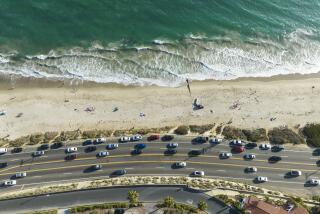Old Pipes Are Latest Pollution Suspect : Beach closure: Detected by radar, they might have been used by now-demolished sewage treatment plant in 1930s.
- Share via
As water quality along the coast improved somewhat Saturday, investigators dug for some long-ago buried pipes in a desperate search for the source of a sewage leak that has shut down much of the Huntington Beach waterfront.
Test results indicate that the beach contamination has decreased over the last two days and that bacteria levels have returned to safe levels on half of the four-mile closure area, said Larry Honeybourne, program chief of the county’s water quality section. But because a source has not been identified, officials hesitated to allow water access.
“We are looking at whether there is a mechanism or possibility for a criteria to open a [part of the] beach and still protect the public’s health,” Honeybourne said. “That’s being discussed, but there is no decision right now.”
Bacteria levels have been fluctuating for several days, and officials said it’s possible water pollution along the coast could once again rise to dangerous levels.
Using backhoes, crew members searched at four locations for pipes that were detected by radar along the bike path in Huntington State Beach.
Officials theorize that the pipes might have been used to send waste water from a now-demolished sewage treatment plant on Newland Street to the ocean in the 1930s.
Tests conducted at a city pump station nearby revealed high levels of contaminants, but officials said it’s too early to tell whether the two factors are linked.
A two-inch conduit was found near Beach Boulevard and Pacific Coast Highway, and authorities will continue looking for the pipes to determine what is in them and where they lead, said Michelle Tuchman, Orange County Sanitation District spokeswoman.
“What we’re doing is we’re uncovering clues, and here’s a possible clue,” said Richard Barnard, deputy city administrator. “And of course, we’re investigating that.”
So far, the contaminants appear to be from old sewage or storm water runoffs, Tuchman said. The density levels tend to correlate with the tide, meaning low tides might be pulling the bacteria out of the source into the ocean.
Another theory is that there is an unknown underground passage that is carrying bacteria from the storm drains to the ocean, Tuchman said. Authorities are increasing the number of water samplings in the area, hoping to close in on the source.
“It’s like trying to find a needle in the haystack,” Barnard said.
More to Read
Sign up for Essential California
The most important California stories and recommendations in your inbox every morning.
You may occasionally receive promotional content from the Los Angeles Times.










